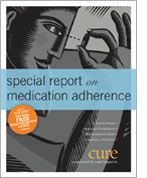Publication
Article
CURE
Alternatives to Adherence?
Author(s):
Alternative medicine is nonadherence at its greatest when it comes to cancer therapy.
Most cancer patients understand the value of traditional treatments, such as radiation and chemotherapy, and accept the side effects and other issues that come with them. But occasionally some patients reject approved treatment protocols in favor of so-called “alternative” therapies.
“That is nonadherence at its greatest,” says Ann Partridge, an associate professor of medicine at Harvard Medical School in Boston. “They are the nonstarters.” When a patient makes such a request, all the provider can do is explain what the patient is risking.
“Our duty is to explain it to them as best we can,” Partridge says. “If they have a highly curable disease, say earlystage breast cancer that can be effectively treated with surgery, and they decide to take mistletoe instead—which I have seen—we explain that they are risking their lives by doing this. We explain the odds of the cancer progressing on mistletoe, which would be quite high, compared to surgery, which would greatly decrease their chances of recurrence.”
Carolyn Blasdel, a family nurse practitioner with the Knight Cancer Institute in Portland, Ore., says that when a patient rejects proven traditional therapy in favor of a questionable alternative approach, she tries to talk the individual into trying a complementary therapy that can be used along with standard medical treatment.
“It’s fine to try some of these other things, but let’s work together,” Blasdel says. “It’s OK to try a complementary approach so long as it doesn’t interfere with the traditional treatment. But some people have a real aversion to taking anything artificial and that can be difficult to deal with. Talking about it sometimes works but not always.”






